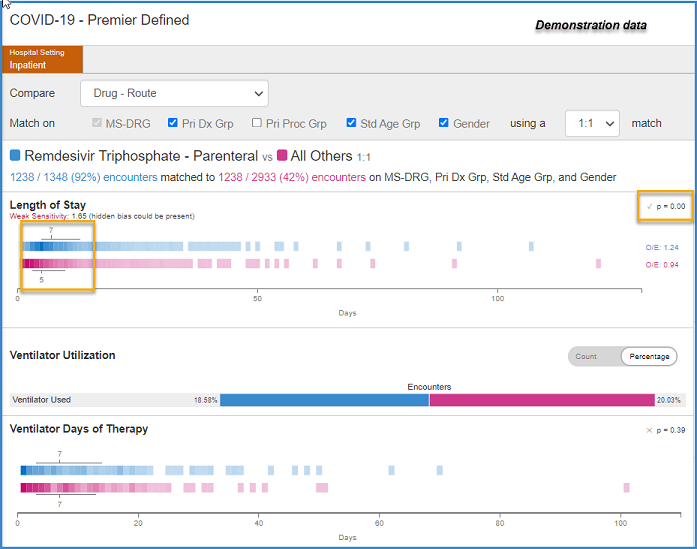How Providers Are Using Data to Determine Drugs’ Appropriate Use

Alongside the ongoing pandemic and potential for new COVID-19 variants, the urgent need for effective drug treatments continues.
But while easy-to-use therapies are vital in the ongoing fight against COVID-19, the expedited approval of novel drugs leaves pharmacy leaders with much of the initial leg work to understand their appropriate use across patient populations.
In 2020, nearly 70 percent of the Food and Drug Administration’s (FDA) novel drug approvals were designated in one or more expedited categories.
These accelerated pathways get new therapies to market sooner, but many times without the immediate benefit of robust research and large datasets that demonstrate efficacy and patient care advancement.
To close this gap, providers are using innovative technology to ensure the patients who should receive specific drugs, get them – all while uncovering opportunities to generate evidence of efficiencies and improve quality.
As one example, let’s look at Remdesivir (RDV), an antiviral therapy authorized by the FDA in May 2020 for emergency use in COVID-19 hospitalized patients:
- A recent publication using four months of observational data from the PINC AI™ Healthcare Database (PHD), a geographically diverse, multi-health system administrative database, suggested improved in-hospital mortality with RDV use across a range of oxygenation requirements at baseline.
- Another observational study that includes over 295,000 patients from the PHD found that use of RDV, corticosteroids and convalescent plasma increased significantly between May and December 2020. RDV utilization increases were noted in patients earlier in their admission for COVID-19 ─ including those who had no supplemental oxygen charges or those who needed low-flow oxygen at baseline ─ while use decreased or remained the same in patients needing high-flow oxygen or invasive mechanical ventilation/ECMO.
Since emergency approval followed by full FDA clearance in October 2020, emerging literature has evaluated use criteria (e.g., length of symptoms and oxygen status), and produced subsequent conflicting findings. A sampling of these various studies is included below. And still today, healthcare providers are seeking to better understand the optimal populations who would most benefit from RDV therapy.
To help translate observational data to the inpatient institutional level, health system pharmacy leaders across the nation turned to PINC AI™ Service Line Analytics-Pharmacy (SLA-Pharmacy), which combines purchasing, utilization and quality data to analyze drug usage and outcomes.
One leading non-profit health system, with more than 8,000 clinicians across its hospitals, medical centers and group practices, analyzed PINC AI SLA-Pharmacy data for nearly 4,000 COVID-19 inpatients ─ half of whom received RDV versus those who did not receive the treatment but received usual care, including steroids. The two groups were ‘pair-matched’ by Medicare Severity-Diagnosis Related Group (MS-DRG), principal diagnosis group, age and gender.
From March through December 2020, the data for this health system showed an average length of ventilator therapy of six days, which was similar to patients not receiving RDV. The pair-matched data for the facility trended similarly regarding readmissions and complications.
Example of pair-matched comparison (demonstration data):

Source: PINC AI SLA-Pharmacy demonstration data; the above is an example and does not reference the data analyses included in this blog.>
Based on emerging literature and their analysis of use in 2020, the health system utilizing PINC AI SLA-Pharmacy made changes to RDV formulary criteria. Similar to the utilization changes noted in observational data, changes at the health system included focusing RDV use on patients who required oxygen but did not need mechanical ventilation, ECMO or high-flow oxygen. In addition, the use of RDV was targeted for patients within a 10-day window from a COVID-19-positive test.
The health system then leveraged PINC AI SLA-Pharmacy to assess the impact of these changes implemented between January-April 2021 (as compared to March-December 2020) and found:
- Both the percentage of ventilated patients and mortality rate were reduced by half for all patients.
- Complications decreased for both groups.
- Readmissions decreased for both groups.
Leveraging PINC AI data gives health systems a holistic view of the treatment’s use in clinical practice, and as a result, enables organizations to better understand where the drug is most beneficial.
Through data-driven decision making, clinicians at this, and other, participating health systems were able to adjust utilization criteria for RDV, resulting in improved patient outcomes. Analysis of hospitals’ utilization data helps drive standardization and allows for a more cost-effective approach to medication selection.
And while the use case above is just one example, more than 450 hospitals across the country have turned to PINC AI SLA to better understand utilization and outcomes for both medications and healthcare supplies.
The bottom line? It’s clear that the data on COVID-19 treatments is still emerging ─ and it’s vital for clinicians to use every tool available to make informed care decisions. Providers leverage industry-leading and data-driven PINC AI clinical decision tools to help clinicians determine drugs’ appropriate use and make evidence-based care decisions that best serve patients. These tools are particularly useful in a pandemic, where clinical management of a disease continues to evolve and can outpace the initiation of new clinical trials.
PINC AI SLA-Pharmacy allows clinicians to corroborate use patterns published in recent and emerging literature at the local, health-system level ─ and it enables health systems to make smarter, evidence-based formulary updates ─ reinforcing appropriate use and treatment decisions in real time.
Beyond COVID-19 treatments, PINC AI SLA-Pharmacy is supporting clinical decision support for therapies across the pharmacy landscape. Influencing clinical practice change with data, these users are generating savings by service line while maintaining or improving quality.
Here’s a quick rundown of the five ways health systems can benefit from deploying PINC AI SLA-Pharmacy:
Identify where your investment in drug cost is focused, with drill-down to the provider level. Benchmark medication utilization to internal and 1,300+ external peers. Evaluate pharmaceutical marketing claims of value. Compare utilization against risk-adjusted outcomes. Monitor variation, spend and outcomes on an ongoing basis.
PINC AI SLA-Pharmacy is powered by Premier’s PINC AI™ platform that includes benchmarking, analytics, reporting and clinical technologies. With one of the largest healthcare datasets in the industry, PINC AI provides actionable intelligence that improves outcomes, supports improved financial performance and enables success in new, alternative payment models.
“The ability to view overall utilization compared to peers and compare outcomes for Remdesivir vs. non-Remdesivir patients was key to highlighting the need to have clear restrictions on remdesivir to ensure appropriate utilization and reduce costs.”
- Kathy Koehl, System Director of Clinical Pharmacy Services, Riverside Health System
“PINC AI SLA-Pharmacy is becoming a core element of our comprehensive approach to clinical change management related to medication use. It has given us the ability to quickly react to utilization trends, such as the medications we began using for COVID-19. This responsive approach helped us make evidence-based care decisions in a rapidly changing environment, ensuring more of the type of patients most likely to benefit were receiving the drugs. Overall, PINC AI SLA-Pharmacyallows us the ability to look at the impact on outcomes and monitor utilization rates and savings. It’s a tool that supports all phases of our medication improvement processes.”
– Rox Gatia, Director of Pharmacy, Henry Ford Health System
"Incorporating PINC AI SLA-Pharmacyinto our formulary management process has facilitated a new approach to clinical improvement. We are forming better medication use partnerships with medical staff leadership, in part because we can quickly answer their most pressing utilization and outcomes questions ─ with our own data. It has quickly become core to our strategy for next-generation clinical stewardship.”
– Jerry Storm, Senior Vice President of Pharmacy Services and Sandra Salverson, Vice President of Pharmacy Operations, OSF HealthCare
Learn more about PINC AI Service Line Analytics (SLA-Pharmacy) and the PHD data.
And for more on studies that have evaluated RDV use criteria:
- Remdesivir for the Treatment of Covid-19 — Final Report
- The safety, tolerability and mortality reduction efficacy of remdesivir; based on randomized clinical trials, observational and case studies reported safety outcomes: an updated systematic review and meta-analysis
- Remdesivir use and outcomes during the FDA COVID-19 emergency use authorization period
- Remdesivir for the treatment of COVID-19
Sudha has over 20 years of experience in helping health systems navigate challenges and priorities in pharmacy practice and the pharmaceutical supply chain. As part of Premier’s pharmacy leadership team, Sudha focuses on member relations, GPO value offerings and advocacy.
Patricia has over 20 years of experience in healthcare, including operating room nursing, infection prevention, and healthcare informatics. Patricia leads teams of clinical and technical resources that deliver both real-time surveillance and patient care tools, as well as analytics solutions that enable healthcare systems to maximize their performance by bridging resource utilization, cost and clinical outcomes.
Kathryn leverages her nearly 20 years of experience as a medication safety expert, health system pharmacy executive and operational change agent as she leads service model strategy for the Premier Pharmacy Field Team. She collaborates across the Premier enterprise to design programs that give Premier Pharmacy members new opportunities to accelerate and market their unique value propositions.
Craig assists in leading the Service Line Analytics (SLA) Operations Team and provides clinical support to new and existing SLA-Pharmacy members. He assists members during implementation and in ongoing support of SLA-Pharmacy and instructs pharmacists on how to best utilize SLA to address clinical variation of their medication utilization using benchmarks and outcomes data.
Sudha has over 20 years of experience in helping health systems navigate challenges and priorities in pharmacy practice and the pharmaceutical supply chain. As part of Premier’s pharmacy leadership team, Sudha focuses on member relations, GPO value offerings and advocacy.
Patricia has over 20 years of experience in healthcare, including operating room nursing, infection prevention, and healthcare informatics. Patricia leads teams of clinical and technical resources that deliver both real-time surveillance and patient care tools, as well as analytics solutions that enable healthcare systems to maximize their performance by bridging resource utilization, cost and clinical outcomes.
Kathryn leverages her nearly 20 years of experience as a medication safety expert, health system pharmacy executive and operational change agent as she leads service model strategy for the Premier Pharmacy Field Team. She collaborates across the Premier enterprise to design programs that give Premier Pharmacy members new opportunities to accelerate and market their unique value propositions.
Craig assists in leading the Service Line Analytics (SLA) Operations Team and provides clinical support to new and existing SLA-Pharmacy members. He assists members during implementation and in ongoing support of SLA-Pharmacy and instructs pharmacists on how to best utilize SLA to address clinical variation of their medication utilization using benchmarks and outcomes data.